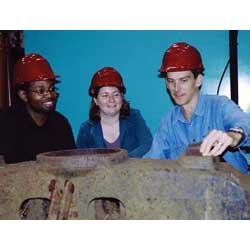Rail CRC research to lead changes in bogie rotation management
Published on 06 March, 2006
Wheel wear on 3-piece bogies in Australia costs the rail industry millions of dollars per annum, with wear increases due to poor bogie rotation estimated to be upwards of 17% of current wheel wear statistics.
Rail CRC research being undertaken as a collaborative project between Central Queensland University and University of Wollongong has made significant progress towards results which could see industry implement wide-spread changes to bogie rotation management, and the use of centre bowl liners to help reduce friction and wear.
 CQU Project Leader Scott Simson has developed a model and simulations which have confirmed industry’s anecdotal evidence in relation to the fact that bogie rotation is an important factor in keeping wheel wear down, reducing friction and reducing fuel consumption.
CQU Project Leader Scott Simson has developed a model and simulations which have confirmed industry’s anecdotal evidence in relation to the fact that bogie rotation is an important factor in keeping wheel wear down, reducing friction and reducing fuel consumption.
According to QR National’s Rollingstock Wagon Maintenance Coordinator, Bruce Brymer, who is heavily involved with the project, one of the elements the research has proven is that bogies steer better when you rotate a worn wheel from rear to forward due to the worn wheel profile.
“Overall, the project has the potential to educate industry how to tune bogies for the right rotational resistance for the traffic and conditions they perform with, to reduce wheel wear, reduce hunting, reduce bogie component wear and reduce fuel consumption,” Mr Brymer said.
For Project Manager, Scott Tapsall, Project Coordinator for Wagons at QR, another outcome of the research has been the model showcasing the fact that changes in the transition design curve have the potential to nullify the effects of centre bowl friction which causes warp in bogies.
“The Rail CRC model has found that bogies may not turn far enough in curve transitions causing significant wear in the outside wheels,” Mr Tapsall said.
“If we made the transition tighter than the curve and then relaxed it into the curve, the bogie would turn further bringing less wear,” he said.
While the model still needs industry testing and strong cost-benefit analyses to validate its findings, it has already provided significant beneficial information to the industry.
At the University of Wollongong, the second element of the research has seen researchers investigate alternatives to centre bowl liners and test different surface treatments on standard metallic liners to develop a superior centre bowl liner for industry use.
According to Mr Brymer the accelerated tests conducted on centre bowl materials done at the University of Wollongong can also give industry validated data and confidence in the centre bowl products they are using.
“While there’s still a long way to go, there’s definitely been some good stuff to come out of the research so far that industry will be able to use,” Mr Tapsall said.
Laboratory and industry testing of the wagon model and centre bowl liner materials are expected throughout 2006 and 2007, with project completion by mid 2008. For further information about the project please contact Scott Simson at CQU on s.simson@cqu.edu.au .
Photo: CQU researcher Scott Simson (right) with Rail CRC students Okwuchi Emereole and Michelle Pearce.

